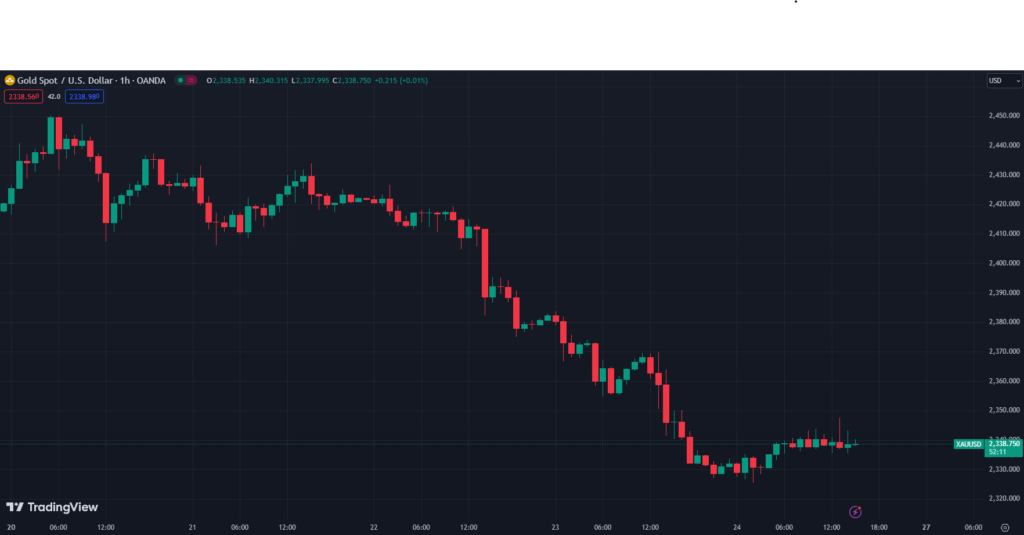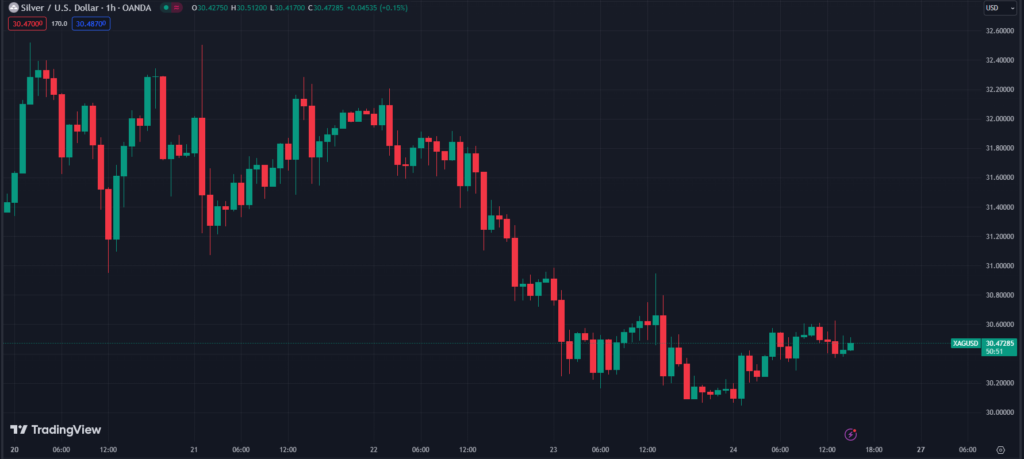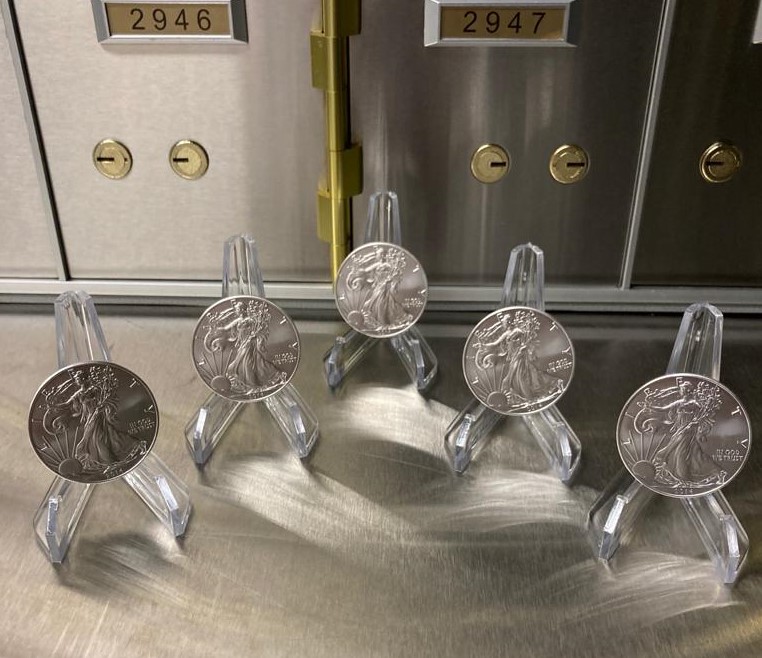
24/05/2024: This Week in Gold with Market Updates:
Price Action:
Gold Price:
Gold opened the week trading at $2,415 per ounce after closing the previous week 2.3% higher, marking the metal’s second consecutive weekly move to the upside. Gold had a more subdued week this week when compared to the previous week, with price closing lower for 3 out of the 5 trading days.
On Monday, gold opened at $2,415 and consolidated for much of the day with little fluctuation. There were multiple FED speakers on Monday, hence the caution within gold markets. Gold ultimately finished 0.5% higher to close the day at $2,427 per ounce.
On Tuesday, gold began to decline gradually throughout the day. Opening at $2.427 per ounce, price fell a total of $6 which equated to a daily decline of 0.2%. Consolidation in the DXY and Treasury Yields provided little motivation for gold to make a major move higher or lower.
On Wednesday, price opened at $2,421 per ounce and a clear bearish trend was noticeable for the day. Gold’s push to the downside was influenced by a strengthening DXY. Price closed $42 lower, moving the precious metal back below the $2,400, to $2,379 per ounce. This was a 1.7% decline.
On Thursday, gold experienced its largest daily decline for the week. This was influenced by various economic data releases that dampened any upside potential that gold may have had for the day. U.S. Manufacturing, Composite, and Services PMI all beat expectations, signalling a strengthening and robust economy. A strengthening economy and gold prices are generally inversely related. Gold closed the day 2.1% lower at $2,329 per ounce. Conversely, DXY showed further strengthening throughout the day, while Treasury Yields were also seen to climb and close the day higher.
On Friday, gold opened at $2,329 per ounce. After an early move higher, price consolidated for most of the day. At the time of writing, gold is trading at $2,339 per ounce, meaning it is on track to close the week 3.1% lower.

Silver Price:
Silver opened the week trading at $31.50 per ounce, after breaking through $30 the week prior. Silver experienced a huge surge during the previous trading week, climbing 11.8% in total. This momentum did not carry into the current trading week, with price showing consolidation early on in the week before making a gradual decline mid-week and consolidating again at the end of the week.
At the time of writing, silver is trading at $30.47 per ounce, meaning it is on track to close the week 3.3% lower.

Market Updates:
22/05/2024: U.K. CPI & U.K. Core CPI
U.K. CPI:
Consumer Price Index (CPI) data for the U.K. was released on Wednesday. CPI measures the average change over time in the prices paid by consumers for a basket of goods and services, making it a key indicator of inflation.
For the month of April, the U.K. CPI (Y-o-Y) came in at 2.3%, higher than the expected 2.1% but significantly lower than the previous month’s 3.2%. On a monthly basis, CPI (M-o-M) was 0.3%, also higher than the expected 0.2% but lower than March’s 0.6%.
U.K. Core CPI:
The U.K. Core CPI, which excludes volatile items such as food and energy, showed a year-over-year increase of 3.9%, exceeding the expected 3.6% but down from the previous month’s 4.2%. Month-over-month, Core CPI rose by 0.9%, surpassing both the expected 0.7% and the previous month’s 0.6%.
These inflation figures suggest a cooling trend compared to the previous month, though they still exceed market expectations. This mixed inflation outlook might result in cautious market sentiment regarding future monetary policy by the Bank of England, impacting gold prices which typically rise in times of economic uncertainty.
23/05/2024: EU, U.K., U.S. PMI & Initial Jobless Claims
EU PMI:
Thursday saw the release of multiple Purchasing Managers’ Index (PMI) reports, which are economic indicators derived from monthly surveys of private sector companies. The EU Manufacturing PMI came in at 47.4, higher than the expected 46.2 and the previous month’s 45.7. The EU Composite PMI, which combines both manufacturing and services data, was 52.3, slightly above the expected 52. The EU Services PMI held steady at 53.3, below the expected 53.6 but unchanged from the previous month.
The improvement in EU Manufacturing PMI suggests a slower contraction in the sector, while the steady services figures indicate ongoing resilience. These mixed signals could lead to varied investor sentiment towards precious metals, with gold and silver potentially seeing limited safe-haven demand amidst a cautiously optimistic economic outlook in Europe.
U.K. PMI:
In the U.K., Manufacturing PMI rose to 51.3, exceeding the expected 49.5 and up from the previous month’s 49.1, indicating expansion in the manufacturing sector. The U.K. Composite PMI came in at 52.8, down from the previous month’s 54.1, while Services PMI fell to 52.9 from the expected 54.7 and the previous month’s figure of 55.
The stronger-than-expected Manufacturing PMI could be seen as a positive sign for the U.K. economy, potentially reducing the immediate appeal of gold as a safe-haven asset. However, the decline in Services PMI might keep some level of investor caution, supporting precious metal prices to some extent.
U.S. PMI:
The U.S. Manufacturing PMI edged up to 50.9, surpassing the expected 50.1 and the previous month’s 50. The U.S. Composite PMI saw a significant rise to 54.4 from the previous 51.3, and the Services PMI increased to 54.8, well above the expected 51.5 and the previous 51.3.
Initial Jobless Claims:
Initial Jobless Claims came in at 215,000, lower than the expected 220,000 and down from the previous week’s 223,000. This lower-than-expected figure indicates a robust labour market, which could lead to increased consumer spending and economic growth.
The strong PMI readings and lower jobless claims suggest a solid U.S. economic outlook, potentially decreasing the demand for gold and silver as safe-haven assets. However, should inflation concerns resurface due to strong economic activity, this could lower investor expectations for rate cuts which may lower have a direct impact on gold’s upside potential.
Conclusion:
This week’s economic data presents a mixed picture for the gold and silver markets. While cooling inflation in the U.K. and higher PMI readings in the EU and U.K. may reduce the immediate need for safe-haven assets, the robust U.S. economic data could lead to inflationary concerns, dampening interest rate cut expectations and limiting gold’s move higher. Investors should continue to monitor these indicators closely, balancing their outlook on economic growth, inflation, and future monetary policy when considering gold and silver investments.

